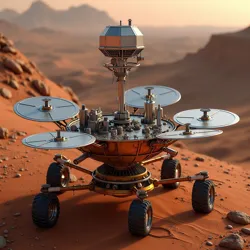Hellas Impact Basin Observatory

The main telescope array of the Hellas Impact Basin Observatory at sunset
Hellas Planitia, Mars
2456 A.M.
Eastern Basin League
Long-range atmospheric analyzer, quantum spectroscope array, gravimetric sensors
Earth atmospheric composition, solar activity, deep space phenomena
The Hellas Impact Basin Observatory is one of Mars' most advanced astronomical research facilities, situated within the ancient Hellas Planitia impact crater. Founded in 2456 A.M. (After Migration), the observatory leverages the unique atmospheric conditions and geological features of the basin to conduct detailed observations of Earth and other celestial bodies. Operating under the authority of the Eastern Basin League, the facility has become crucial in monitoring Earth's environmental evolution since the Great Collapse.
History and Construction
Site Selection
The Hellas Impact Basin was chosen for the observatory's location due to several advantageous features. The basin's exceptional depth, reaching nearly 7 kilometers below the Martian datum, provides significantly higher atmospheric pressure than anywhere else on Mars. This unique environment, combined with the remarkably stable atmospheric conditions within the crater, creates ideal conditions for astronomical observation. The Aquifer Technocracy provided crucial support during the initial construction phase, ensuring reliable water supply for the facility's cooling systems.
Development Phases
Construction of the observatory occurred in three major phases spanning over four decades. The initial phase, completed in 2456 A.M., established the primary telescope array and basic research facilities. The second phase, finished in 2478 A.M., added the advanced atmospheric analysis equipment that would later prove crucial in studying Earth's changing environment. The final phase, completed in 2498 A.M., introduced the Telluscope Array, a revolutionary system designed specifically for detailed observation of Earth's surface and atmosphere.
 The observatory's primary atmospheric monitoring array, capable of detecting minute changes in Earth's atmospheric composition from Mars
The observatory's primary atmospheric monitoring array, capable of detecting minute changes in Earth's atmospheric composition from MarsTechnical Capabilities
Atmospheric Analysis Systems
The observatory's most significant achievement has been the development of long-range atmospheric composition analysis technology. Using a combination of spectroscopic analysis and advanced light-gathering techniques, the facility can detect and measure changes in Earth's atmospheric makeup with remarkable precision. This capability has proved invaluable to the Terran Restoration Movement, providing crucial data about Earth's current habitability.
Deep Space Observation
Beyond its Earth-watching mission, the observatory maintains significant deep space observation capabilities. The facility's location within the Hellas Basin provides unique advantages for astronomical research, particularly in studying solar activity and its effects on Mars' artificial atmosphere. The observatory works closely with the Guild of Atmospheric Sciences to provide early warnings of solar events that might affect Mars' environmental systems.
Research Programs
Earth Monitoring Initiative
The observatory's primary research focus remains the systematic observation of Earth's environmental conditions. Through decades of careful study, researchers have documented significant changes in Earth's atmosphere, including gradual shifts in composition that suggest ongoing natural recovery processes. These findings have generated considerable debate among members of the Blight Quarantine Theory movement, with some arguing that the data indicates potential future habitability.
Atmospheric Science
The facility maintains an extensive research program focused on understanding the relationship between Mars' artificial atmosphere and natural atmospheric processes. This work has proven essential for maintaining the delicate balance of Mars' terraformed environment, with findings regularly shared with the Atmosphere Wardens and other environmental management authorities.
Cultural Impact
Scientific Legacy
The Hellas Impact Basin Observatory has become a symbol of Mars' enduring scientific ambition despite the loss of many advanced technologies following the Great Collapse. The facility's success in maintaining and advancing astronomical research capabilities has inspired similar projects across Mars, including the establishment of the Olympus Zenith Research Center.
Public Engagement
While primarily a research facility, the observatory maintains several public education programs that have significantly influenced Martian society's understanding of Earth and space science. Regular public viewings and educational sessions have helped maintain scientific literacy among the general population, particularly regarding Earth observation and atmospheric sciences.
 The observatory's public viewing gallery, where citizens can observe Earth through specially designed telescopes
The observatory's public viewing gallery, where citizens can observe Earth through specially designed telescopesRecent Developments
Technical Innovations
Recent years have seen several significant advances in the observatory's capabilities, including the development of new high-resolution imaging systems and improved atmospheric analysis tools. These innovations have allowed for more detailed study of Earth's recovery patterns and have provided new insights into the long-term effects of the Great Collapse on Earth's biosphere.
Future Projects
The observatory is currently developing the next generation of observation equipment, including advanced gravimetric sensors designed to detect subtle changes in Earth's crustal movement patterns. These new capabilities are expected to provide even more detailed information about Earth's current condition and its potential for future human habitation.
See Also
- Phobos Observatory
- Universities of Olympus
- Chronicians of Olympus
- Deimos Data Cache